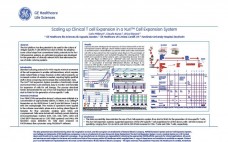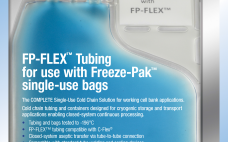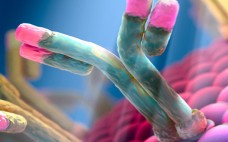Working cell banks (WCB’s) are commonly applied to initiate cell culture manufacturing campaigns for production of therapeutic proteins. These campaigns typically begin with inoculation of cells previously cryopreserved in vials. While vials are typically used to establish WCB’s and initiate manufacturing campaigns, they are not optimal for the growing demands of commercial production. Vials are small and filling/removal is performed through an open cap. This process leads to numerous manual operations and culture vessels, resulting in contamination risks and potential…
Sponsored Content
Ask the Expert: Taking Medium and Feed Development Beyond Maximizing Protein Titer to Optimizing Glycan Distribution and Simplifying Process Scale-Up
with Serena Fries Smith (Thermo Fisher Scientific) In the early 2000s, maximizing expression titers was the industry’s biggest challenge. Over the past 10–15 years, significant advances in media and feeds have enabled standard fed-batch processes to achieve 3 g/L, some as high as 7 g/L. The productivity increase is enabling scientists to move beyond titer and focus resources on addressing other scientific challenges (e.g., product quality modulation and process scale-up). One way to address those challenges is by leveraging feed…
Scaling Up Clinical T cell Expansion in a Xuriâ„¢ Cell Expansion System
Administration of antigen-specific T cells (ASTs), in particular for viral infections in transplantation, is one of the key focuses in immunotherapy. The Xuriâ„¢ Cell Expansion System can be used as an alternative to static cell culture methods for the stimulation and expansion of ASTs. The process described here demonstrates the use of the Xuri Cell Expansion System from the initiation of culture to the generation of virus-specific T cells. This includes a semi-static phase for antigen stimulation, a rocking phase…
Development of a Novel Thermoplastic Tubing, FP-FLEX and Single-Use Freezing Bag for Working Cell Banks Enabling Closed-System Processing to Temperatures as Low as -196 °C
This webcast features: Dominic Clarke, Global Product Manager, Charter Medical Working cell banks (WCB’s) are commonly applied to initiate cell culture manufacturing campaigns for production of recombinant or therapeutic proteins. These campaigns typically begin with inoculation of cells previously cryopreserved in cryovials. While cryovials are typically used in the development of WCB’s and initiation of manufacturing campaigns, they are not optimal for the growing demands of commercial production. Cryovials are small and filling/removal is performed through an open screw cap. This…
Product Quality Assessment using N-linked Glycan Analysis by LC-MS Supports Identification of Commercially Viable Cell lines for Biopharmaceuticals
This webcast features: Gareth Meek-Brown, Lead Scientist, Lonza Biologics – Slough Product Quality assessment during Upstream and Downstream Process Development is key to the production of safe and efficacious biopharmaceuticals. Critical quality attributes such as N-linked glycosylation are highly dependent upon biosynthesis conditions and play a crucial role in the pharmacology of therapeutic proteins, potentially affecting immunogenicity, pharmacokinetics and pharmacodynamics. The presence of N-linked glycosylation has benefits including increased thermal, physical and chemical stability over aglycosylated variants. The optimum N-linked…
Optimizing Cell Culture Productivity: New Findings on the Impact of Recombinant Protein Supplements
This webcast features: Harris Grevelis, Product Manager for Upstream Technologies at Repligen Cell culture supplements are essential for long-term growth and productivity of cell lines in serum-free media formulations. Both insulin and LONG®R3 IGF-I, a more potent supplement that directly targets and activates the IGF-I receptor, are employed by the biopharmaceutical industry today to support the growth of recombinant cell lines. This webinar will show how these two supplements, used separately and in combination, impact viable cell density and IgG…
Characterization of Subvisible Particles in Vaccine Development
Vaccine manufacturers want meaningful information that can be linked to process knowledge to increase product quality and eliminate patient safety issues. New requirements from the United States Pharmacopeial Convention (USP) and the U.S. Food and Drug Administration (FDA) put pressure for root cause analysis to understand impact on changes during process and product development. The new demands involve not only size and distribution but deeper characterization that involves morphology and composition studies as part of particle characterization. Nanoparticles like virus,…
Taking Medium and Feed Development Beyond Maximizing Protein Titer to Optimizing Glycan Distribution and Simplifying Process Scale-Up
This webcast features: Serena Fries Smith, Process Science Manager, Thermo Fisher Scientific In the early 2000s when many processes were struggling to achieve 1 g/L, maximizing titers was the industry’s biggest challenge and was essential to having favorable cost of goods and an economically viable product. Over the last 10-15 years, the industry has made significant advances in media and feeds. Due to these advancements, today a standard fed-batch process can typically achieve 3 g/L and some processes are achieving…
Your Reliable Contract Manufacturing Solution Partner in China
This whitepaper focuses on Boehringer Ingelheim’s development and manufacturing facility in China. As one of the world’s leading organizations in the area of biopharmaceutical contract manufacturing, Boehringer Ingelheim is the first multi-national pharmaceutical company that brings over 30 years of experience in biopharmaceutical contract manufacturing to China, to better serve patients and the biopharmaceutical industry – both in China and in the world. As a pioneer in biopharmaceuticals with more than 35 years of experience the company has brought more…
How Molded Manifold Assemblies Prevent Leaks & Costly Consequences
Molded tubing manifolds have roles to perform over and above being a transport vehicle for liquids. The assemblies must maintain leak-proof flow. They need to meet sterility requirements and help limit the need for cleaning and associated validations. They also must be cost effective, simple to use and efficient. When compared with hand-assembled tubing sets, the advantages of molded tubing manifold assemblies are clear. Tubing sets made from multiple components present a risk of leaks at every juncture. With barbed…










